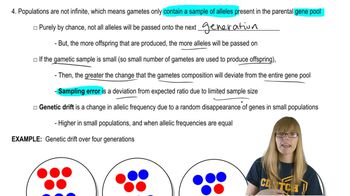Divide the contents of a large bag of different-colored candies randomly and approximately equally among the members of the group. Do not pick specific candy colors, but simply empty the contents of the bag onto a table and quickly divide the pile. If you are doing this exercise by yourself, divide the contents of the bag into five piles. Have each person compare the frequencies of each color in they pile with the frequencies in the original bag. Describe any differences in frequency between the pile and the original bag.
Table of contents
- 1. Introduction to Genetics51m
- 2. Mendel's Laws of Inheritance3h 37m
- 3. Extensions to Mendelian Inheritance2h 41m
- 4. Genetic Mapping and Linkage2h 28m
- 5. Genetics of Bacteria and Viruses1h 21m
- 6. Chromosomal Variation1h 48m
- 7. DNA and Chromosome Structure56m
- 8. DNA Replication1h 10m
- 9. Mitosis and Meiosis1h 34m
- 10. Transcription1h 0m
- 11. Translation58m
- 12. Gene Regulation in Prokaryotes1h 19m
- 13. Gene Regulation in Eukaryotes44m
- 14. Genetic Control of Development44m
- 15. Genomes and Genomics1h 50m
- 16. Transposable Elements47m
- 17. Mutation, Repair, and Recombination1h 6m
- 18. Molecular Genetic Tools19m
- 19. Cancer Genetics29m
- 20. Quantitative Genetics1h 26m
- 21. Population Genetics50m
- 22. Evolutionary Genetics29m
21. Population Genetics
Allelic Frequency Changes
Problem 41c
Textbook Question
Put all the candies used in Problem 40 into a single mound and then divide them into four equal piles, this time being sure that the frequency of each color is the same in each pile. Label two of these piles 'male' and the other two 'female.' Half of the group will take one male and one female pile, and the other half of the group will take the other two piles. Each half of the group will carry out its own experiments: Determine the frequency of each candy color in the total of 25 draws (a total of 50 candies) and compare these frequencies with the original frequencies of the colors in the pile.
 Verified step by step guidance
Verified step by step guidance1
Step 1: Combine all the candies from Problem 40 into a single mound. Ensure that the total number of candies and their respective colors are accounted for accurately.
Step 2: Divide the mound into four equal piles, ensuring that the frequency of each candy color is distributed equally across all four piles. This requires calculating the proportion of each color in the original mound and distributing them accordingly.
Step 3: Label two of the piles as 'male' and the other two as 'female.' Ensure that the labeling is clear and consistent for the subsequent experiments.
Step 4: Split the group into two halves. Assign one male and one female pile to the first half of the group, and the other male and female piles to the second half of the group. Each half of the group will use their assigned piles for experiments.
Step 5: For each group, conduct 25 draws (a total of 50 candies) and record the frequency of each candy color. Compare these frequencies with the original frequencies of the colors in the mound to analyze any deviations or patterns.
 Verified video answer for a similar problem:
Verified video answer for a similar problem:This video solution was recommended by our tutors as helpful for the problem above
Video duration:
2mPlay a video:
Was this helpful?
Key Concepts
Here are the essential concepts you must grasp in order to answer the question correctly.
Genetic Variation
Genetic variation refers to the differences in DNA sequences among individuals within a population. This variation is crucial for evolution and natural selection, as it provides the raw material for adaptation. In the context of the candy experiment, the different colors represent genetic traits, and understanding their distribution helps in analyzing how traits are inherited and expressed.
Recommended video:
Guided course

Genomic Variation
Sampling and Frequency Distribution
Sampling involves selecting a subset of individuals from a larger population to estimate characteristics of the whole. Frequency distribution is a statistical method that shows how often each color appears in a sample. In this experiment, drawing candies and calculating the frequency of each color allows for comparison with the original distribution, providing insights into randomness and bias in sampling.
Recommended video:
Guided course

Genetic Drift
Experimental Design
Experimental design is the process of planning an experiment to ensure valid and reliable results. It includes defining control and experimental groups, randomization, and replication. In this scenario, dividing the candies into male and female piles and having two groups conduct separate experiments exemplifies a controlled approach to test hypotheses about color frequency and inheritance patterns.
Recommended video:
Guided course

Transformation
Related Videos
Related Practice
Textbook Question
397
views


